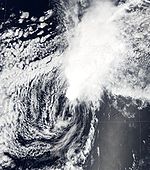2001 Pacific hurricane season
| 2001 Pacific hurricane season | |
|---|---|

Season summary map
|
|
| Seasonal boundaries | |
| First system formed | May 25, 2001 |
| Last system dissipated | November 3, 2001 |
| Strongest storm | |
| Name | Juliette |
| • Maximum winds | 145 mph (230 km/h) (1-minute sustained) |
| • Lowest pressure | 923 mbar (hPa; 27.26 inHg) |
| Seasonal statistics | |
| Total depressions | 19 |
| Total storms | 15 |
| Hurricanes | 8 |
| Major hurricanes (Cat. 3+) |
2 |
| Total fatalities | 9 |
| Total damage | $400 million (2001 USD) |
| Related articles | |
| Category 4 hurricane (SSHWS) | |
| Duration | May 25 – June 1 |
|---|---|
| Peak intensity | 145 mph (230 km/h) (1-min) 940 mbar (hPa) |
| Tropical storm (SSHWS) | |
| Duration | June 20 – June 26 |
|---|---|
| Peak intensity | 60 mph (95 km/h) (1-min) 997 mbar (hPa) |
| Tropical storm (SSHWS) | |
| Duration | July 13 – July 15 |
|---|---|
| Peak intensity | 45 mph (75 km/h) (1-min) 1000 mbar (hPa) |
| Tropical storm (SSHWS) | |
| Duration | July 20 – July 24 |
|---|---|
| Peak intensity | 40 mph (65 km/h) (1-min) 1001 mbar (hPa) |
| Category 1 hurricane (SSHWS) | |
| Duration | July 21 – July 28 |
|---|---|
| Peak intensity | 75 mph (120 km/h) (1-min) 982 mbar (hPa) |
| Tropical depression (SSHWS) | |
| Duration | August 22 – August 24 |
|---|---|
| Peak intensity | 35 mph (55 km/h) (1-min) 1007 mbar (hPa) |
| Category 2 hurricane (SSHWS) | |
| Duration | August 26 – September 2 |
|---|---|
| Peak intensity | 105 mph (165 km/h) (1-min) 972 mbar (hPa) |
| Category 2 hurricane (SSHWS) | |
| Duration | September 4 – September 10 |
|---|---|
| Peak intensity | 100 mph (155 km/h) (1-min) 975 mbar (hPa) |
| Tropical storm (SSHWS) | |
| Duration | September 4 – September 8 |
|---|---|
| Peak intensity | 65 mph (100 km/h) (1-min) 994 mbar (hPa) |
The 2001 Pacific hurricane season was a near average season. The most notable storm that year was Hurricane Juliette, which caused devastating floods in Baja California, leading to 12 fatalities and $400 million (2001 USD; $5.41 billion 2017 USD) worth of damage. Two other storms were notable in their own rights, Hurricane Adolph became the strongest May Hurricane until 2014 when both records set by Adolph and Juliette were broken by Hurricanes Amanda and Odile. Tropical Storm Barbara passed just north of Hawaii, bringing minimal impact. The season officially began on May 15, 2001 in the eastern Pacific, and on June 1, 2001 in the central Pacific, and lasted until November 30, 2001. These dates conventionally delimit the period of each year when most tropical cyclones form in this part of the Pacific Ocean. The first storm developed on May 25, while the last storm dissipated on November 3.
The 2001 Pacific hurricane season officially started May 15, 2001 in the eastern Pacific, and June 1, 2001 in the central Pacific, and lasted until November 30, 2001. These dates conventionally delimit the period of each year when most tropical cyclones form in the northeastern Pacific Ocean. In practice, however, the season lasted from May 25, the formation date of its first system, to November 3, the dissipation date of the last.
There were fifteen tropical storms in the eastern Pacific Ocean in the 2001 season. Of those, seven became hurricanes, of which two became major hurricanes by reaching Category 3 or higher on the Saffir Simpson Scale. Four tropical depressions formed and dissipated before reaching the intensity of a named storm. In the Central Pacific Hurricane Center's area of responsibility, only one tropical depression developed. In the eastern Pacific proper, the season saw average activity in terms of the number of systems, but with the intensity of the storms, the season was considered below average, with only seven hurricanes and two major hurricanes. This season had only one named storm in the month of June, and only one during August. Also of note this season is an unusual gap in storm formation during the first three weeks of August. That time usually sees several nameable storms, but for some reason there were none.
Hurricane Adolph originated from a tropical wave that left Africa on May 7, and was poorly organized. It was not until May 18 that the storm showed some signs of development in the Atlantic Ocean. On, May 22 the wave crossed over, and on May 25 it intensified into Tropical Depression One-E, about 250 mi (400 km) south-southwest of Acapulco, Mexico. The system, after drifting a while, intensified into Tropical Storm Adolph the next day. Later, on May 27 Adolph was upgraded to a hurricane. Intensifying into a hurricane, Adolph rapidly intensified, and reached to Category 4 strength on May 28. Two days after, Adolph went under an eyewall replacement cycle, and weakened to a 115 mph (185 km/h) hurricane, which is minimal category 3 intensity. This trend of weakening continued, and deteriorated into a tropical storm. Passing over cooler waters, and stable air, Adolph dissipated on June 1.
...
Wikipedia


















